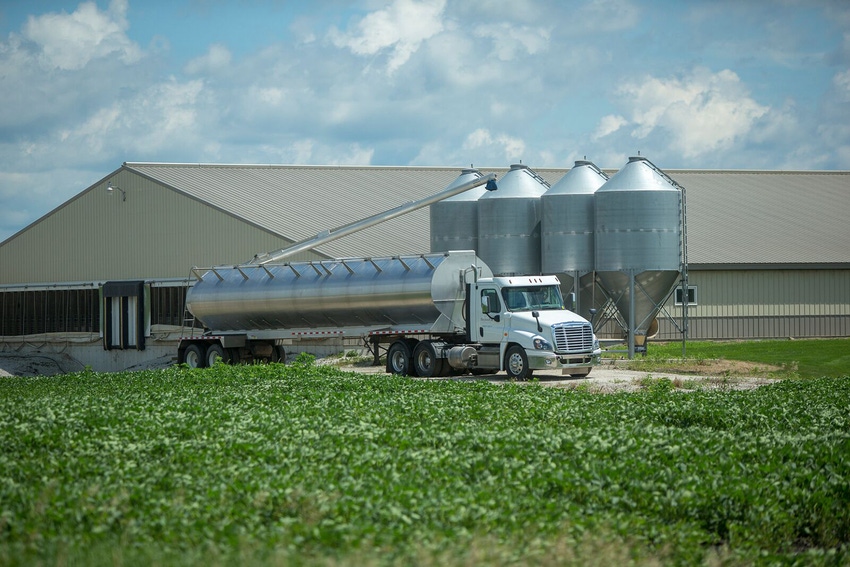Post-epidemic dynamics of PEDV in the United States
Farms located in medium-density counties twice more likely to experience outbreaks than farms in low-density counties.
January 11, 2022

Porcine epidemic diarrhea is a swine enteric viral disease first documented in the U.S. swine population in 2013, at which time it sparked a major epidemic [1]. Since then, PED virus has persisted in the U.S. breeding herd with low incidence during the post-epidemic period. Despite continued monitoring and surveillance, there is minimal research and understanding of the endemic phase of PEDV in the country.
During the epidemic, different publications cited several risk factors associated with the rapid spread of PEDV (animal movements, truck contamination, slaughter plant contamination, contaminated feed and feed-mills and farm employees among others) [2]–[5]. However, after containment of the initial epidemic (around mid-2014) minimal research has been published on the endemic state of PED in the United States. The prevalence since then has been less than 10%.
Our objective was to characterize PED in the U.S. breeding herd in the post epidemic period (spatial-temporal distribution of cases and associated factors ). We used data from 1,100 breeding farms in 27 states, whose PED statuses were routinely reported to the Morrison Swine Health Monitoring Project between July 2014 and June 2021. We stratified the data into six regions over which mixed-effects logistic regression analyses and spatial-temporal analyses were done.
For the study period, a total of 625 outbreaks of PEDV were recorded on 373 farms. The total number of farms breaking per year reduced from 95 farms in 32 counties in 11 states between July 2014 and June 2015 to 53 farms in 28 counties in nine states between July 2020 and June 2021, indicating an overall decrease in occurrence and spatial extent of PEDV. The mean incidence risk declined from 8% ± 7% (July 2014 and June 2015) to 5% ± 3% (July 2020 and June 2021).
Outbreaks were seasonal, with most outbreaks occurring during winter (January-March – p = 0.001, relative risk =2.2). However, in some regions, seasonal clusters started in December. Ten spatial-temporal clusters of PED cases (p < 0.05), spanning 2.5 square kilometers to 833.7 km2 and one to five months, were recorded in four regions. Eight of the clusters were observed between 2015 and 2019 in three regions and one in 2021 in one region. Farms in these clusters were from 16 systems.
After controlling for the season, farm type and year, the occurrence of PED cases on farms was associated with county-farm-density, with farms located in medium-density counties (0.013-0.031 farms/km2) twice more likely to experience outbreaks than farms in low-density counties (< 0.013 farms/km2) (p < 0.001) (Figure 1). As such, farms in some regions were more likely to experience outbreaks than other regions, and the odds of PED outbreaks on farms decreased through the study period.
The overall decline in PED cases over the years and the decrease in spatial extent likely reflects ongoing efforts employed by production systems to control PEDV during the post-epidemic period. This presents an opportunity for concerted and coordinated efforts to understand PEDV dynamics in nursery and growing herds and initiate strategic steps towards regional and subsequently national elimination of PED in the United States.
This research was funded in part through the Swine Health Information Center.
References
[1] A. Scott et al., "Porcine epidemic diarrhea virus introduction into the United States: Root cause investigation," Prev. Vet. Med., vol. 123, pp. 192–201, Jan. 2016.
[2] S. Dee et al., "An evaluation of contaminated complete feed as a vehicle for porcine epidemic diarrhea virus infection of naïve pigs following consumption via natural feeding behavior: proof of concept," BMC Vet. Res., vol. 10, no. 1, p. 176, 2014.
[3] E. B. O'Dea, H. Snelson, and S. Bansal, "Using heterogeneity in the population structure of U.S. swine farms to compare transmission models for porcine epidemic diarrhoea," Sci. Rep., vol. 6, 2016.
[4] L. L. Schumacher et al., "Characterizing the rapid spread of porcine epidemic diarrhea virus (PEDV) through an animal food manufacturing facility," PLoS One, vol. 12, no. 11, p. e0187309, Nov. 2017.
[5] Y. Kim, M. Yang, S. M. Goyal, M. C. J. Cheeran, and M. Torremorell, "Evaluation of biosecurity measures to prevent indirect transmission of porcine epidemic diarrhea virus," BMC Vet. Res., vol. 13, no. 1, p. 89, Dec. 2017.
Sources: Dennis Makau, Kimberly VanderWaal, Mariana Kikuti, Catalina Picasso-Risso, Emily Geary and Cesar A. Corzo, who are solely responsible for the information provided, and wholly own the information. Informa Business Media and all its subsidiaries are not responsible for any of the content contained in this information asset.
You May Also Like



